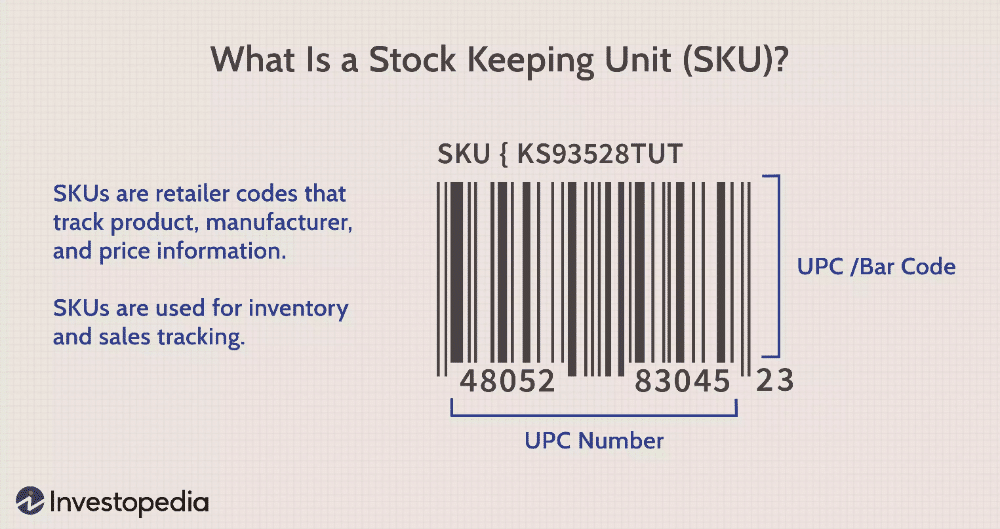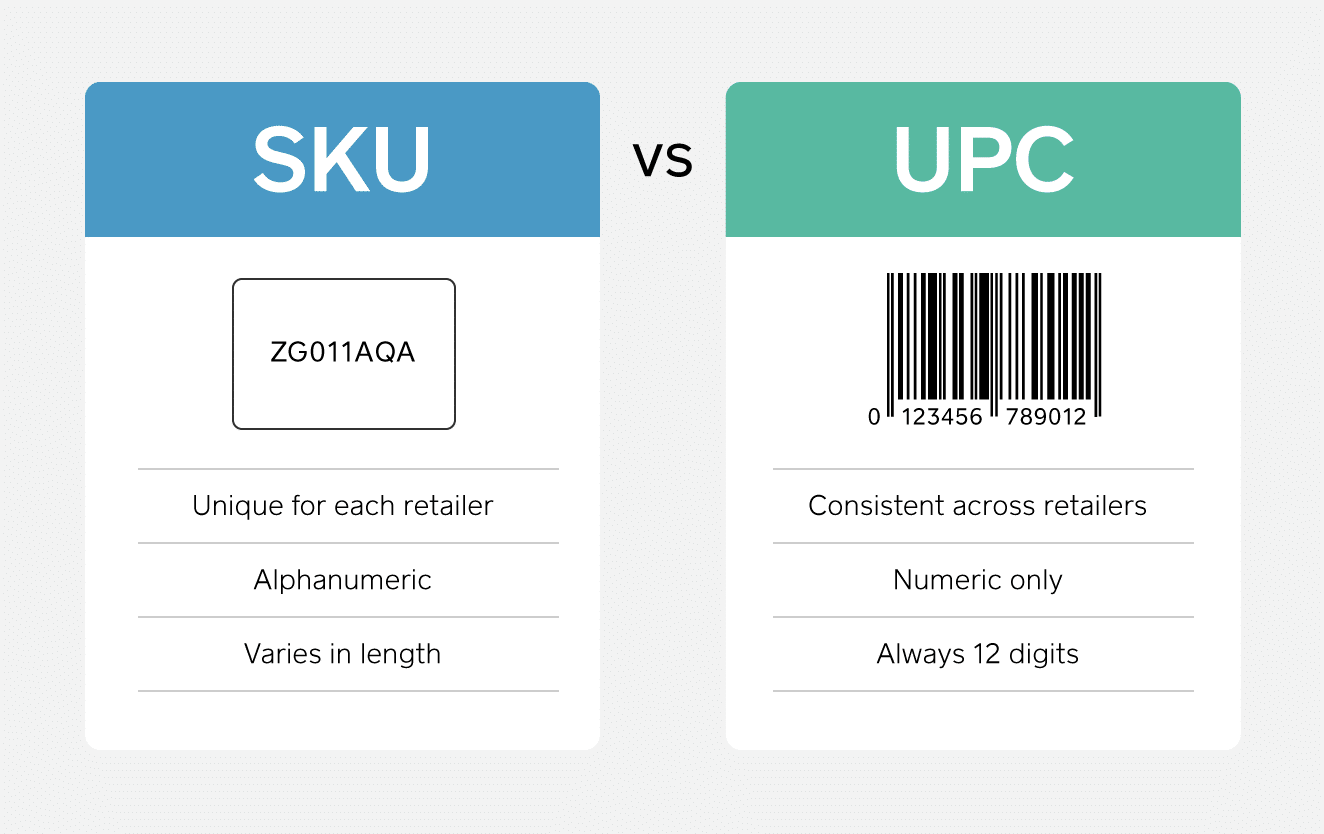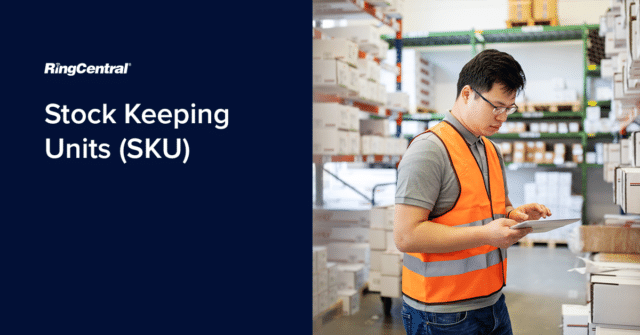If you’re a retail business today, the chances are that you are already using SKU numbers. Retail technology is changing, and the point-of-sale is increasingly moving online. Businesses should consider what system to have in place to make online order fulfilment more efficient.
There are several solutions for fulfilment and inventory management. Having an effective SKU system in place will help your business improve customer experience. It will streamline your inventory management system, whichever you choose to adopt.
If you are a new business or unsure of what exactly an SKU number is and how to implement it, you have come to the right place.
Definition of an SKU Number

An SKU is a stock keeping unit number. It is a unique alphanumeric code assigned to specific products stocked by a retailer. The code allows businesses to monitor and manage inventory efficiently. Codes can typically be eight to 12 characters long.
Unlike UPC barcodes, SKU numbers are unique to each retailer and based on whatever system a business finds best suits its inventory. The alphanumeric system can represent brands, colour, size and type of item.
Other unique identifiers could include the type of warranty or packaging of a product. And usually, an SKU number will go further and denote which department an item belongs in.
How is an SKU calculated?
While SKUs are created by and unique to each business, there are several best practices. Certain basics should be considered when building an SKU code system.
A retailer must decide how to build SKU numbers to fit their business model and the type of inventory they deal with. SKU architecture can fit into a massive online retailer like Amazon or a local, small business.
Almost any point-of-sale (POS) system will let you build your own SKU architecture. Businesses can also look to SKU generators to provide an effective model. But you must first understand how these systems create SKU architecture. Then it will be easier for your business to maximise the benefits of using SKU numbers. It will also be easier to adopt and implement them.
Typically, an SKU will begin with a top-level identifier. This is usually a code to denote the brand or the department. The middle of the code will identify unique information such as colour, size and subcategories.
Each retailer will need to organise the categories of information to fit their inventory. The end of the code will need to be a sequential number for further differentiation.
Why SKU numbers are important for store owners
SKU numbers will help any business become more organised and efficient with managing stock. However, retailers will gain several other benefits from implementing the use of an SKU architecture.
1. Store design

Whether in eCommerce or brick-and-mortar retail stores, a well-crafted SKU system will help with the design of your store. Using the SKU codes, similar products will be easy to find and group in the correct departments. The customer experience will be improved because the orderly design will make it easier for them to find what they are looking for.
2. Checkout
An SKU system will streamline the checkout experience for your customers. Effective SKU codes will avoid human error and make sure all items are priced accurately.
SKUs used in conjunction with a POS system will eliminate stock errors. Customers will never be informed that an item is out of stock only when checking out online.
3. Inventory management
Having an SKU number system in place will help your business easily manage your inventory levels. SKU numbers will help you know exactly how many of an item is in stock, and you will have this information available in real-time.
This means that your business will be alerted in a timely fashion when stocks are low and items need to be reordered. Nothing is more frustrating than losing a sale because an item is back-ordered.
Access to SKU data can also give businesses great customer insights. Forecasting for future stock purchases will be more accurate. You will spend only on items that your customers want. SKU numbers will help your inventory management system prevent overstocking less desired items.
4. Shipments
When items are shipped, an SKU list will help ensure that shipments are accurate and avoid human error in transit. An SKU system will also help to organise your warehouse logically. Orders will be faster for your team to put together and process. Customers will then receive their items on time, all the time.
You will also be able to track inventory that ships easily. And, of course, the stock will be updated in real-time as the item is scanned out of inventory whilst leaving the warehouse.
5. Data visualisation
In addition to tracking stock level in real-time, other information can be gleaned from SKU data. Even if you are using an Excel spreadsheet, you can conduct spot checks for inventory levels with little effort. Type in the department code or any other identifier, and you will have access to the necessary information.
You can use this information to dictate effective reorder points and gain valuable customer demand insight.
6. Loss prevention

In the world of retail, shrinkage is an assumed risk of doing business. And for larger retailers, it is straightforward for items to go missing. Items with SKU numbers will be easier to account for. SKU data will help your business pinpoint shrinkage areas with greater granularity. This will make it easier for you to manage risk and reduce losses.
How to Set Up SKU Numbers
Setting up SKU numbers for your business is quite simple. A few decisions will have to be made about what information is important. That information will then need to be prioritised. But there are three basic steps to follow:
-
Start with a top-level identifier
An SKU code should start with information that identifies an important category. Typically, retailers find it useful to start with the brand name of the item or the department it belongs in. For example, if the item is a guitar, a retailer could start with FN for Fender or EG for electric guitar.
-
Use the middle to become more specific

The code in the middle will be used to define unique identifiers for the item. Most of the time, you will want to use at least two code elements here. With the guitar example, we could use 06 for six strings and BLK for black. Typically size or colour is at the end of the sequence as it is the least important information.
So now the code would be FEN-06-BLK. But there are a lot of six-string Fender guitars. A music retailer should add another code. This imagined guitar is an American Stratocaster so let’s add AMS in there. So now the code is FEN-06-AMS-BLK.
Fender is a brand, but they also make more than just electric guitars. They make all kinds of products, including basses and amplifiers. So instead of starting with the brand, we could start with the department. We will use EG6 for a six-string electric guitar. We can then write an SKU code for the same guitar as EG6-FN-AMS-BLK.
This shows that there are many ways to create the SKU. An SKU generator may have the best template for your type of business, but it’s always best to think about what works for you.
-
Finish with a sequential number
At the end of an SKU, you will finish the code with a sequential number. This sequential number will be beneficial in separating last year’s stock from the current year. Or even just separating any newly updated item from its predecessor.
So now we finish with EG6-FN-AMS-BLK-01. “01” represents that the guitar was manufactured in 2001. For a seasonal product, “01” could represent the first quarter or the month of January.
Best practices in creating SKUs
An SKU system with the necessary components will successfully order and track a retailer’s inventory. But relaying important information is not the only rule for creating an effective SKU architecture.
There are several best practices to avoid confusion, errors, and a loss of a functional system.
1. Keep it simple
While at first, it may be tempting to come up with all sorts of descriptive codes, with SKU numbers, less is more. Aim for eight to twelve characters, but avoid going over sixteen.
Opt for two characters instead of three when possible. Take the colour black, for instance; BK will probably work just as well as BLK.
Use dashes or underscores to separate each identifier. This will make the SKU number much easier to read and easier to identify the item.
2. Most important to least important

Sometimes it can be not easy to decide what information is most important when creating an SKU architecture. Remember that the SKU code is not for the customer to use but for retail management.
So, what is the most important category for the business when it searches for a product within the inventory management system? This will always vary for each retailer but should be easy to discover when viewed in this light.
3. Don’t confuse alpha and numerical
Because implementation of an SKU system involves humans, make sure to reduce the potential for human error. Avoid letters like “O” or a capital “I”, which look like digit numbers. Sometimes this may even apply to the number “5” and letter “S”. Make it easy on yourself and your staff. Avoid any potential headaches that character ambiguity can cause.
4. No special characters, spaces, or symbols
The only non-numeric characters you need are “-“ and “_” to help separate SKU code identifiers. Anything else is unnecessary. And avoid the temptation for spaces, as these can also lead to confusion.
Any other special characters and symbols can not only confuse team members. They can also disrupt programs like Excel and other tools of inventory management.
SKU frequently asked questions
Are SKU and barcode the same?
A barcode is a visual representation of a set of characters. This is normally represented by vertical lines varying in width. Barcodes are machine-readable by optical scanners.
Modern two-dimensional barcodes can be read by mobile software and smartphones. A barcode can represent a unique SKU number to be machine-readable.
What is the difference between an SKU and a UPC?

The Universal Product Code (UPC) is a barcode standard set by the not-for-profit global standards organisation, GS1. 12 digits represent a UPC in barcode form. UPCs are used as part of a business language to identify products across the globe. It is not to be used in place of stock-keeping unit numbers.
SKUs use alpha and numeric values and can range in length from eight to 16 characters or more. Each retailer will have its own unique SKU system, and it’s not used in selling items but in tracking them.
How do I generate an SKU code?
Generating different SKUs for different products manually can be as easy as following the instructions in this guide. But it can also be time-consuming.
For simplicity, both TradeGecko and Zoho offer free Excel SKU generators. For a monthly fee, retailers can have a more flexible and streamlined process with an online tool from Primaseller.
In the future
Creating an effective SKU architecture will help your business save money and time. Implementation of SKU numbers will also help you to glean money-saving insights with better stock control. Customers will experience more streamlined shopping and avoid stock-related frustrations.
RingCentral’s one-stop-shop offers diverse and flexible solutions to improve customer experience. Personalise communication with your customers with online chat and SMS support. Keep shoppers up-to-date for deliveries and click and collect services. RingCentral can integrate with all of your apps, including your inventory management system.
Contact RingCentral today to streamline your customer shopping experience!
Originally published May 13, 2021, updated Aug 06, 2021

